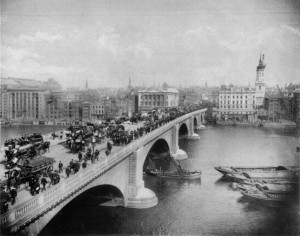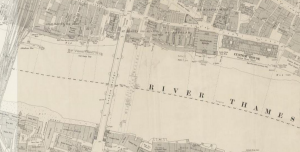The bridges of London are crossroads of international commerce and markets but they are also a place for crime especially during the Victorian Era. There was everything from pocket picking to assaults. One case I found in the Old Bailey Proceedings that occurred in the summer of 1894 documents a case in which a bargeman pulled a gun and fired at a group of boys that were noted to have been seen throwing stones at boats from the London Bridge (. Not much else is noted about the individual who was injured and brought charges against the bargeman but modern readers can almost picture such a bustling waterway full of commerce and life but also conflict.

London Bridge was an especially busy place with a very rich history. In Old and New London¸ writer Walter Thornbury states that London Bridge “was a battle-field and a place of religious worship, a resort of traders and a show-place for traitors’ heads.” During the Tudor reign, it was regularly used to showcase the heads of those convicted of treason. It has a dark history its transformation into one of the main trade centers in London makes it a perfect place to examine in the context of “A Lost Masterpiece.” London was still advancing technologically and socially before the turn of the century when this short story takes place. The movement of time as well as modern movement is important to understand Victorian texts.
The narrator in “A Lost Masterpiece,” states that she “boarded a river steamer bound for London Bridge.” There is a theme of social mobility present in London society at this time which is why so many people came in from the countryside for the opportunities London had. The narrator herself establishes this by stating she had come in from the countryside because she was bored with life there and missed the excitement of London and all the inspiring material it presented for her literary endeavors. Physical mobility is also represented by the steamer the narrator boards at Chelsea and London Bridge. The travel from West to East along the Thames could be a symbol for the migration of individuals from the country to the city. It also represents the movement occurring within London itself, which the narrator observes as she simultaneously acknowledges her role in the scheme of things. She declares, “I was simply an interested spectator of a varied panorama.” As the keen observer, she is capturing images of several different kinds of Londoners as she herself becomes part of this inner city movement. The language she uses to describe her thoughts are also tied to movement, she is “touching a hundred vagrant things with the magic of imagination, making a running comment on the scenes we passed.” By transitioning to using the word ‘we’ instead of the word ‘I’ as she frequently does in the beginning, the narrator has moved from an outsider in London to part of the London dwellers she describes. Additionally, she describes her thoughts as ‘running’, which further reinforces the theme of movement.
Works Cited
Egerton, George. “A Lost Masterpiece.” The Yellow Nineties Online. The Yellow Nineties Online, n.d. Web. 05 Sept. 2015.
Old Bailey Proceedings Online (www.oldbaileyonline.org, version 7.2, 05 September 2015), July 1894, trial of WILLIAM BAVINGTON (50) (t18940723-626).
Walter Thornbury, ‘London Bridge’, in Old and New London: Volume 2 (London, 1878), pp. 9-17 http://www.british-history.ac.uk/old-new-london/vol2/pp9-17 [accessed 1 September 2015].
“Victorian Google Maps.” Victorian Google Maps. Google, n.d. Web. 05 Sept. 2015.
http://www.victorianweb.org/victorian/art/architecture/feist/30.html


Daniela, I really liked how you analyzed not only the royal side of the story, but the dark history as well. I find it hard to believe that such a booming society would still display the heads of their enemies in public – I thought that type of behavior was reserved for the Vikings. I’ll have to do more research. Your information has really made me understand how London Bridge came to be such an iconic place, and it’s interesting to find out how its infamy began.
Hey Carly 🙂 The displaying of the traitor’s heads was done during the turbulent Tudor dynasty, not the Victorian Era. I just thought it was worth mentioning the history of the bridge.